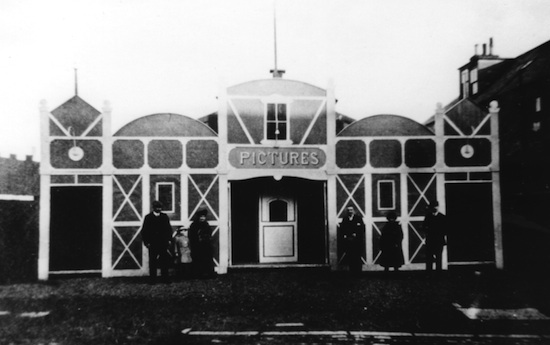Dr Hanita Ritchie, Archivist and Local History administrator at the John Gray Centre, delivered an entertaining talk covering the development of cinema in Scotland in general and Haddington cinemas in particular. Early beginnings in the late 19th century saw the introduction of cinematograph performances at what was called the Empire Theatre (now Festival Theatre) in Edinburgh. Many other mobile ‘cinemas’ were to be found in church halls, ice rinks, theatres and other community spaces. This was the situation throughout WW1 after which the growing popularity of film drove the construction of cinema (picture) houses in cities and towns throughout the country. The advent of ‘talkies’ from 1929/1930 further increased popular interest in cinema. The art deco style picture houses many of us remember were built during this period. During WW2 cinema was very much at the heart of public entertainment, and a major source of public information and propaganda. Its popularity continued into the 1950s and early 1960s, but audiences declined steadily over these years due at least in part to the influence of television. This led to the conversion of many cinemas, particularly provincial ones, into bingo halls. Although there was a resurgence of interest in cinema from the 1980s, with many famous Holywood ‘blockbusters’ leading the way, many of the old city cinemas were converted into multiplexes, and newly built ones conformed to this design. A very few survivors in their original form include the Cameo in Edinburgh. Many provincial old picture houses simply disappeared to make way for other developments.
This historical pattern was followed in Haddington. From the late 19th century peripatetic cinematic entertainment was to be found in public halls, church premises and so forth. Records show that the Corn Exchange was a cinema centre from 1904 (entrance 2/- or 1/6p). Similarly the Public Hall in Gifford and Forester Hall in North Berwick also served this function for a time. The main name behind the early development of Haddington Cinema in the Edwardian period and through to the early 1920s was William Cadona. In the early days he ran a ‘mobile’ cinema and rented Ball Alley from the council as a site for his set-up, for the princely sum of 30/- per week (roughly £90, modern equivalent).
In 1915 plans were put to the Council to build a picture house at Skinner’s Close on the Hardgate. The building was completed, and opened on 08 February 1918 as ‘Haddington Picture House’. The first film was ‘The Shielding Shadow’ – 2nd episode! By 1922 Codona was no longer involved in Haddington and the Picture House closed. He continued for a time with the Winton Cinema in Tranent and the Prestonpans Picture House (the ‘Scratcher’ !). Robert Scott rented the Corn Exchange from 1922, with wooden benches and piano. ‘Talkies’ made it to Haddington in 1932 at the Corn Exchange: Columbia Pictures, ‘Africa Speaks’ and ‘The Criminal Code’. In 1933 The New County Cinema opened in Hardgate on the site of the old Picture House and served until 1944 when it was destroyed by fire. The story goes that film caught fire in the projector and the burning material was removed and thrown out on to the cinema passageway.
Plans to rebuild were accepted and the replacement building retained the art deco frontage of its predecessor. It opened in 1946, the first films shown being ‘Tall in the Saddle’ (with John Wayne and Ward Bond) and ‘Belle of the Yukon’ (with Randolph Scott and Gypsy Rose Lee). In 1947 it screened the wedding of Princess Elizabeth and Prince Phillip. The cinema continued through the 1950s into the mid sixties where declining interest led to its conversion into a bingo hall in 1966. The final film shown was ‘Don’t Lose Your Head’ with the cast of the Carry On series. Finally, in 1990 the cinema was demolished and replaced by the block of flats which loom over the Hardgate today.
Hanita concluded by inviting members of the audience to contribute any memories of cinema in Haddington and East Lothian, several of which were forthcoming. For example, we were reminded of the common practice at children’s matinees in the 1950s and perhaps later, to use jam jars or glass lemonade bottles as currency to buy admission.
Peter R

Images courtesy of the Scottish Cinema and Theatres website

You must be logged in to post a comment.